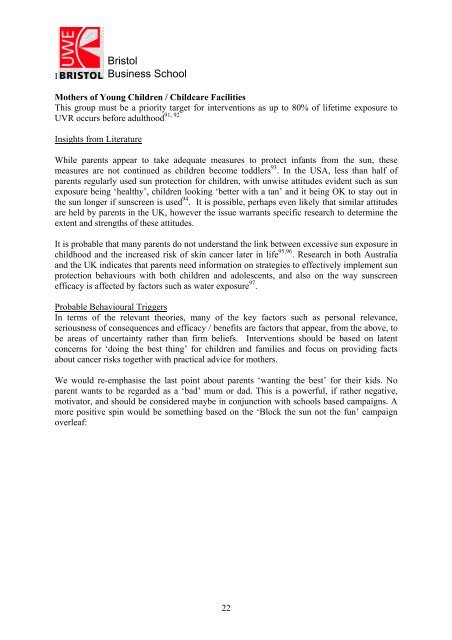PDF (Sun Protection / Skin Cancer Detection Report for the South ...
PDF (Sun Protection / Skin Cancer Detection Report for the South ...
PDF (Sun Protection / Skin Cancer Detection Report for the South ...
You also want an ePaper? Increase the reach of your titles
YUMPU automatically turns print PDFs into web optimized ePapers that Google loves.
I<br />
Bristol<br />
Business School<br />
Mo<strong>the</strong>rs of Young Children / Childcare Facilities<br />
This group must be a priority target <strong>for</strong> interventions as up to 80% of lifetime exposure to<br />
91, 92<br />
UVR occurs be<strong>for</strong>e adulthood<br />
Insights from Literature<br />
While parents appear to take adequate measures to protect infants from <strong>the</strong> sun, <strong>the</strong>se<br />
measures are not continued as children become toddlers 93 . In <strong>the</strong> USA, less than half of<br />
parents regularly used sun protection <strong>for</strong> children, with unwise attitudes evident such as sun<br />
exposure being ‘healthy’, children looking ‘better with a tan’ and it being OK to stay out in<br />
<strong>the</strong> sun longer if sunscreen is used 94 . It is possible, perhaps even likely that similar attitudes<br />
are held by parents in <strong>the</strong> UK, however <strong>the</strong> issue warrants specific research to determine <strong>the</strong><br />
extent and strengths of <strong>the</strong>se attitudes.<br />
It is probable that many parents do not understand <strong>the</strong> link between excessive sun exposure in<br />
childhood and <strong>the</strong> increased risk of skin cancer later in life 95,96 . Research in both Australia<br />
and <strong>the</strong> UK indicates that parents need in<strong>for</strong>mation on strategies to effectively implement sun<br />
protection behaviours with both children and adolescents, and also on <strong>the</strong> way sunscreen<br />
efficacy is affected by factors such as water exposure 97 .<br />
Probable Behavioural Triggers<br />
In terms of <strong>the</strong> relevant <strong>the</strong>ories, many of <strong>the</strong> key factors such as personal relevance,<br />
seriousness of consequences and efficacy / benefits are factors that appear, from <strong>the</strong> above, to<br />
be areas of uncertainty ra<strong>the</strong>r than firm beliefs. Interventions should be based on latent<br />
concerns <strong>for</strong> ‘doing <strong>the</strong> best thing’ <strong>for</strong> children and families and focus on providing facts<br />
about cancer risks toge<strong>the</strong>r with practical advice <strong>for</strong> mo<strong>the</strong>rs.<br />
We would re-emphasise <strong>the</strong> last point about parents ‘wanting <strong>the</strong> best’ <strong>for</strong> <strong>the</strong>ir kids. No<br />
parent wants to be regarded as a ‘bad’ mum or dad. This is a powerful, if ra<strong>the</strong>r negative,<br />
motivator, and should be considered maybe in conjunction with schools based campaigns. A<br />
more positive spin would be something based on <strong>the</strong> ‘Block <strong>the</strong> sun not <strong>the</strong> fun’ campaign<br />
overleaf:<br />
22

















